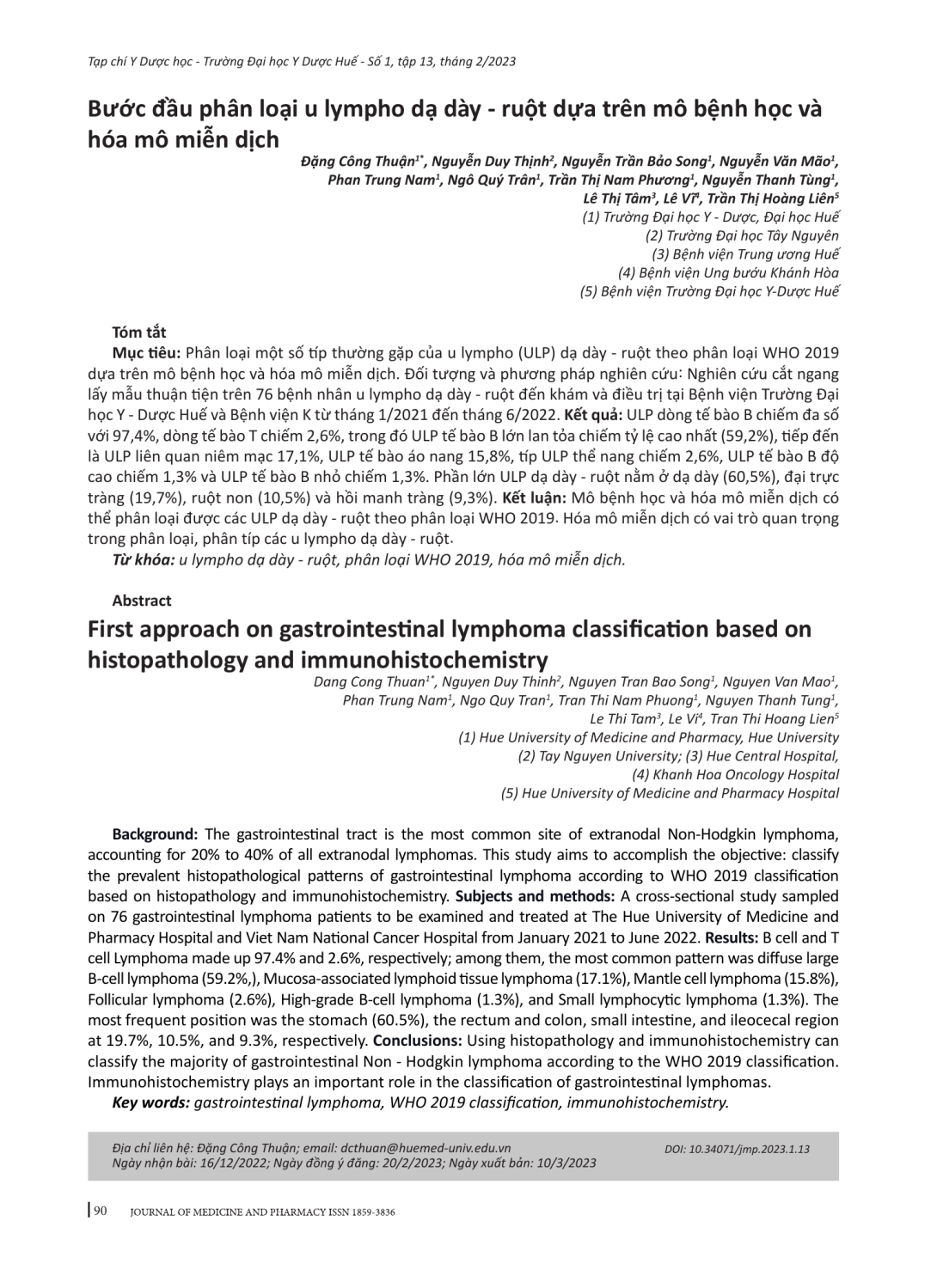
Phân loại một số típ thường gặp của u lympho (ULP) dạ dày - ruột theo phân loại WHO 2019 dựa trên mô bệnh học và hóa mô miễn dịch. Đối tượng và phương pháp nghiên cứu: Nghiên cứu cắt ngang lấy mẫu thuận tiện trên 76 bệnh nhân u lympho dạ dày - ruột đến khám và điều trị tại Bệnh viện Trường Đại học Y - Dược Huế và Bệnh viện K từ tháng 1/2021 đến tháng 6/2022. Kết quả: ULP dòng tế bào B chiếm đa số với 97,4%, dòng tế bào T chiếm 2,6%, trong đó ULP tế bào B lớn lan tỏa chiếm tỷ lệ cao nhất (59,2%), tiếp đến là ULP liên quan niêm mạc 17,1%, ULP tế bào áo nang 15,8%, típ ULP thể nang chiếm 2,6%, ULP tế bào B độ cao chiếm 1,3% và ULP tế bào B nhỏ chiếm 1,3%. Phần lớn ULP dạ dày - ruột nằm ở dạ dày (60,5%), đại trực tràng (19,7%), ruột non (10,5%) và hồi manh tràng (9,3%). Kết luận: Mô bệnh học và hóa mô miễn dịch có thể phân loại được các ULP dạ dày - ruột theo phân loại WHO 2019. Hóa mô miễn dịch có vai trò quan trọng trong phân loại, phân típ các u lympho dạ dày - ruột.
The gastrointestinal tract is the most common site of extranodal Non-Hodgkin lymphoma, accounting for 20% to 40% of all extranodal lymphomas. This study aims to accomplish the objective: classify the prevalent histopathological patterns of gastrointestinal lymphoma according to WHO 2019 classification based on histopathology and immunohistochemistry. Subjects and methods: A cross-sectional study sampled on 76 gastrointestinal lymphoma patients to be examined and treated at The Hue University of Medicine and Pharmacy Hospital and Viet Nam National Cancer Hospital from January 2021 to June 2022. Results: B cell and T cell Lymphoma made up 97.4% and 2.6%, respectively; among them, the most common pattern was diffuse large B-cell lymphoma (59.2%,), Mucosa-associated lymphoid tissue lymphoma (17.1%), Mantle cell lymphoma (15.8%), Follicular lymphoma (2.6%), High-grade B-cell lymphoma (1.3%), and Small lymphocytic lymphoma (1.3%). The most frequent position was the stomach (60.5%), the rectum and colon, small intestine, and ileocecal region at 19.7%, 10.5%, and 9.3%, respectively. Conclusions: Using histopathology and immunohistochemistry can classify the majority of gastrointestinal Non - Hodgkin lymphoma according to the WHO 2019 classification. Immunohistochemistry plays an important role in the classification of gastrointestinal lymphomas.
- Đăng nhập để gửi ý kiến
